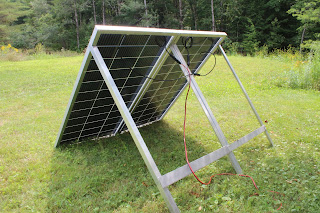.jpg) |
| 4 195W and 2 440W panels |
After I set up my new ground mounted solar array recently (4 195W panels) I realized that I was only getting peak power of around 350W, so I decided to order a couple more 240 W panels from Amazon. When they arrived (in a cardboard box weighing almost 80 pounds!) one of them was damaged beyond repair so I sent them back and then started looking online for solar dealers here in Maine. I was surprised and delighted to find a company called Greentech Renewables that had just opened up a huge warehouse a few months ago. They are about 15 minutes from my home so I stopped by and talked to their salesperson Eric who was very friendly. I told him I was looking for a couple of high power solar panels around 450 W and he said he had quite a number of them. So I asked him what the dollars per Watt was for these panels and he said that they were about $0.35. Wow! When I installed my first 20 panels 16 years ago the cost was nearly $4 per Watt, prices have really come down! And the icing on the cake is that these panels were assembled in the USA by Canadian Solar, so no tariffs involved!
So I paid for them and said I would come back in an hour or two with my trailer to pick them up. I didn't realize how big these panels would be until I got there. They are almost 4 x 6' and required two people to move them. They put 2 on a shipping pallet and fork lifted them onto my trailer. I asked if I could keep the pallet which is constructed from fresh clean looking 2X6 lumber and they said "Sure!". So I cut them up with my chainsaw and I'm using them to heat my workshop:
I then went to my local metal supplier and purchased some angle aluminum so I could construct a hinged mount that I bolted right on to the back of the 2 new panels. The metal strip on the bottom is secured to the ground with tent pegs so they can't blow over. Of course I will need to shovel snow away from the front of them in the winter, but that's a small price to pay and I do have a snowblower.
.jpg)
UPDATE! In mid December an unusual southerly wind storm with gusts over 40MPH blew them all over. Fortunately they were not damaged. Solar panels are very strong - like automobile windows. I fixed broken mounts and secured them with 18" screw ground anchors that I got from Harbor Freight.
Here's the front view of the full solar array with the newest panels on the right:
You can also see the solar thermal solar collectors that are used to heat the hot water in my house and a 250 W solar panel that also works as a sunshade for the second floor bedroom.
Wiring for this array was complicated. In order to optimize power there are two pairs on the left wired in series and the large ones on the right are wired in parallel and then they all combined in parallel to feed into the inverter. Since the panels are different voltages, the power defaults to the lowest voltage which is a compromise, but so far it's working okay.
According to my calculations they should be producing peak power of 1000 W, but in reality it peaks a 960W. The screenshot below shows the energy produced for the last several days. Day one was the original four panels panels, day two I added the first of two 440 W panels, and then on day three I connected the second 441 panel. As you can see I'm offsetting my electric bill by about 3.6 kWh per day which will really add up.
The other thing affecting my electric bill is that the utility company has been slowly ramping up a surcharge for those of us with solar. Years ago there was no surcharge, then it went to $22 and now about $44 per month which adds up to $528 per year. I understand the reasoning, because they have no revenue from me to support the infrastructure, but $44 seems egregious considering that my solar panels are enhancing power quality in my region and reducing the load on their transmission lines.
Thanks to net energy billing I get full retail credit for every kilowatt hour that I export back into the grid. Essentially, the utility is paying me for the power I put into their grid and when I reach the point of generating more than a use on an annual basis I will not benefit financially, but that's fine with me. The way that net metering works is that every kilowatt hour I put back into the grid gives me a credit in kilowatt hours. For five months or more in the summer I accumulate credits that I then use up into October and November. At that point the trade-off of solar powered heat pumps doesn't work so well because we have so little sunlight here at 45° latitude and those heat pumps require a lot of energy to operate. My bills in January and February were over $350 this year. So my goal is to accumulate enough credit in the summer to carry me all the way through the winter.
I'm 70 years old now and working at reducing my operating costs by investing some money in solar equipment now so that I don't have to pay it out later to the utilities who are constantly raising their rates. Given the very low cost of solar panels right now, this makes good financial sense as the return on investment is better than the stock market.
.jpg)
.jpg)

.jpg)


.jpg)






.jpg)

.jpg)


.jpg)

.jpg)
.jpg)
.jpg)
.jpg)
.jpg)
.jpg)
.jpg)
.jpg)

















.jpg)
.jpg)

.jpg)